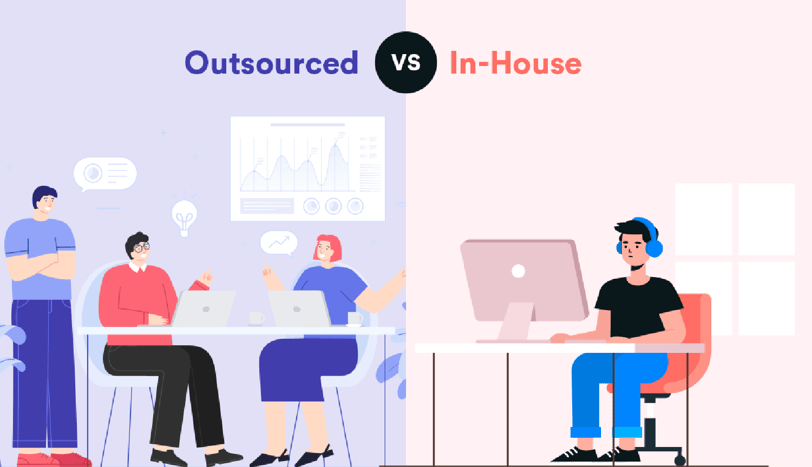The Hidden Costs of Hiring In-House vs Outsourcing: What Startups Must Know
Is your in-house team costing you more than you realize? Explore a detailed breakdown of in-house hiring & outsourcing. Learn how to unlock budget optimization and make a smarter, ROI-focused decision today.
Tejas Khandpur
4/15/20253 min read


Startups often rush to hire in-house talent, believing it provides better control & output. But many overlook the hidden costs—time, energy, money, operational, and opportunity-related to see if the candidate is the right fit for your organization. For Startups, time is of the essence, and money must be spent wisely. For budget-conscious startups, understanding the true cost of hiring in-house vs outsourcing is crucial. Outsourcing might not just save you time and money—it might save your startup and how you structure it. Outsourcing, especially through platforms like TaskXPort, offers a strategic alternative that could not only save money but also speed up your startup's growth. Around 59% of businesses use outsourcing primarily to reduce costs.
In-House vs. Outsourcing: A Detailed Comparison
1. Direct Salary and Compensation:
In-House: Requires a full-time salary, often with benefits like health insurance and paid time off. For example, hiring a developer might cost $60,000 annually.
Outsourcing: Offers flexibility with project-based or hourly rates. For instance, you might pay $30 per hour for a skilled developer.
2. Recruitment Expenses:
In-House: Includes costs for job postings on premium platforms, agency fees, and the significant time spent on interviewing and screening candidates. This can easily amount to $5,000 per hire.
Outsourcing: Typically involves minimal platform fees, often around $50, significantly reducing recruitment costs.
3. Overhead and Operational Costs:
In-House: Incurs substantial overhead, including office space rental, equipment purchases, software licenses, and ongoing maintenance. For example, office rent could be $3,000 per month.
Outsourcing: Eliminates these overhead costs, as service providers handle their own operational expenses.
4. Training and Onboarding:
In-House: Requires significant time and resources for training new employees, which can impact productivity. For instance, a month-long training period.
Outsourcing: Often involves accessing skilled professionals who are immediately productive, reducing onboarding time.
5. Benefits and Perks:
In-House: Adds significant costs through benefits packages like health insurance, retirement plans, and paid time off, which can add up to 20% of the employee's salary.
Outsourcing: Does not involve these costs, as service providers are responsible for their own benefits.
6. Management Time:
In-House: Demands considerable time from founders and managers for employee supervision and administration, potentially diverting focus from core business activities. For example, 20 hours per week.
Outsourcing: Reduces management time through project management tools and escrow services, ensuring streamlined operations.
7. Scaling Flexibility:
In-House: Results in fixed costs, making it difficult to scale teams up or down quickly based on project needs. Adding or removing an employee can take months.
Outsourcing: Offers on-demand scalability, allowing you to adjust resources as needed, potentially adding or removing a developer in days.
8. Risk Mitigation:
In-House: Carries a higher risk of hiring the wrong person, leading to wasted time and resources.
Outsourcing: Reduces risk through client reviews and escrow services, ensuring project reliability and quality.
The True Cost of Hiring In-House
Hiring in-house extends far beyond just salary. Understanding these hidden hiring costs is essential for a sound startup hiring strategy.
Recruitment Costs:
Job postings on premium platforms.
Extensive time spent screening and interviewing candidates.
Background checks and verification processes.
Salary & Benefits:
Competitive salaries to attract top talent.
Comprehensive benefits packages (health insurance, retirement plans).
Office space, equipment, and software licenses.
Time Drain:
Founders and managers spend significant time on employee management.
Reduced focus on core business activities and scaling.
Downtime from employee vacations and sick leave.
Outsourcing: Predictable, Scalable, Lean
For startups seeking agility and cost-effectiveness, the outsource vs in-house cost comparison reveals clear advantages.
Pay for Output, Not Hours:
Payment is tied to deliverables, ensuring efficiency.
Eliminates costs associated with idle time.
No Overhead:
No expenses for office space, equipment, or HR administration.
Reduces operational burdens. Poor communication with a hired team can double expenses and, in 80% of cases, lead to project failure within 2–3 years.
Scale Fast:
Quickly scale teams up or down based on project needs.
Access specialized skills on demand.
Beyond the Price Tag: The Strategic Advantage
Access Global Talent:
Tap into a diverse pool of skilled professionals worldwide.
Overcome geographical limitations in talent acquisition.
Focus on Growth:
Free up internal resources to concentrate on core business development.
Accelerate product development and market expansion.
Built-in Accountability:
Platforms like ours, TaskXPort, offer escrow and project management tools.
Ensure transparency and reliability in project delivery.
Our Value Proposition at TaskXPort:
When you feel like making a judicious choice for your company, book a free 15-minute consultation with us at TaskXPort to discover how smart outsourcing can save you money, time, and sanity, or if you even need outsourcing. Sometimes you do not need outsourcing, and that's okay! When you need us, we will be right there for you. Connect with experienced and thoroughly vetted Indian service providers and streamline your projects. Let us be the matchmaker to find the right TaskXPerts for your needs.
Conclusion:
In a nutshell, the allure of building an in-house team is strong, startups must consider the in-house vs outsourcing for startups debate with a clear understanding of all types of costs. Outsourcing through platforms like ours provides the flexibility, cost control, and access to top-tier talent necessary for sustainable growth.